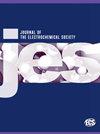Review—Progress in Research and Application of Molten Salt Electrolysis for Titanium Extraction
IF 3.1
4区 工程技术
Q2 ELECTROCHEMISTRY
引用次数: 0
Abstract
Titanium (Ti), a metal known for its exceptional performance, is abundant in nature and holds significant potential for a variety of applications and advancements. However, the conventional Kroll process has faced criticism due to its high energy consumption, complex procedures, and environmental impact. In response, metallurgists worldwide are actively exploring innovative and sustainable methods for Ti production. Titanium metal production is generally classified into two main methods according to the specific raw materials and preparation methods employed: thermal reduction and molten-salt electrolysis. This paper provides a review of these two primary Ti production processes, comparing their respective advantages and suggesting potential areas for improvement and breakthroughs. In particular, we emphasize recent advancements in molten-salt electrolysis, such as the utilization of Ti-rich alloys as raw materials and liquid metals as cathodes. Notably, the advances in molten-salt electrolysis with liquid metal as cathodes show promise for the continuous production of high-purity Ti at reduced costs and energy consumption. We also introduce a novel approach: the preparation of Ti metal through double-chamber molten-salt electrolysis. Additionally, we explore future directions for enhancing the Ti metal production process.综述-熔盐电解法提取钛的研究与应用进展
钛(Ti)是一种以其卓越性能而著称的金属,在自然界中含量丰富,在各种应用和进步方面具有巨大潜力。然而,传统的克罗尔(Kroll)工艺因其高能耗、复杂的程序和对环境的影响而饱受批评。为此,全世界的冶金学家都在积极探索创新和可持续的钛生产方法。根据所采用的特定原材料和制备方法,金属钛的生产一般分为两种主要方法:热还原法和熔盐电解法。本文回顾了这两种主要的钛生产工艺,比较了它们各自的优势,并提出了有待改进和突破的潜在领域。我们特别强调了熔盐电解法的最新进展,如利用富钛合金作为原材料和液态金属作为阴极。值得注意的是,以液态金属为阴极的熔盐电解技术的进步为以更低的成本和能耗连续生产高纯度钛带来了希望。我们还介绍了一种新方法:通过双室熔盐电解制备金属钛。此外,我们还探讨了改进钛金属生产工艺的未来方向。
本文章由计算机程序翻译,如有差异,请以英文原文为准。
求助全文
约1分钟内获得全文
求助全文
来源期刊
CiteScore
7.20
自引率
12.80%
发文量
1369
审稿时长
1.5 months
期刊介绍:
The Journal of The Electrochemical Society (JES) is the leader in the field of solid-state and electrochemical science and technology. This peer-reviewed journal publishes an average of 450 pages of 70 articles each month. Articles are posted online, with a monthly paper edition following electronic publication. The ECS membership benefits package includes access to the electronic edition of this journal.

 求助内容:
求助内容: 应助结果提醒方式:
应助结果提醒方式:


